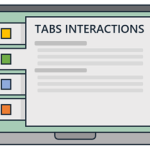[…] Traduzione autorizzata tratta dal post originale di Tom Kuhlmann sul “Rapid E-Learning Blog”. Il post originale è disponibile qui […]

To a novice even simple things seem complex. And when things appear complex, we can become frustrated or feel like we don’t have the skills to accomplish what it is we want to do.
I recall years ago when I was learning video production. I felt like my skills were inadequate (which they were). So my instructor told me to record some television commercials and then break them down into pieces to see how they were built. He said that this would help me focus less on the glossiness of the commercials and more on their construction. So I recorded commercials and then built a storyboard around the different scenes in them. I made notes of the scenes, where the edits were, and what might have motivated the edits.
This exercise was one of the best learning experiences for me. It slowed things down and helped me shift my focus away from the slickness of the commercials (which made my lack of skill more apparent) and move it towards the production process.
For new elearning developers, I recommend a similar process. Find elearning courses you like and then break them down into chunks so it’s easier to understand how the courses were created. This will help you understand some of the techniques used to transition the content and move a learner through the course. But more importantly, it will give you a sense of what’s common about elearning courses and help you think through and plan for those things in your own course development.
Take a book, for example. While every book is different, the structure of every book is similar. There’s a cover, table of contents, chapters, an index, and perhaps an author bio. The same can be said for elearning. Different content, similar structure.
The Basics
In a very simple sense an elearning course is about creating an environment where a person goes from a point of not knowing to knowing. They’re at point A today and tomorrow they need to be at point B. The course is about helping them get from A to B.

Common Course Chunks
While each course has different content, they all generally have a similar structure. Once you begin to recognize that, the development process won’t seem as complex.

Here are what I see as common “chunks” that make up an elearning course.
- Welcome: some sort of title screen that welcomes the learner
- Instructions: review of the interface and how to navigate the course
- Introduction: information about the course and its purpose
- Objectives: learning objectives and reason for taking the course
- Section screens: this is the area that holds the core content. Each section can have its own welcome, instructions, content, assessment, and summary
- Assessment: process to review overall understanding
- Summary: summary of course objectives
- Resources: additional content and resources that augment the course and support ongoing learning
- Exit: next steps and see you later alligator
Obviously theses chunks are generic with the option to reorder or not use all (or any) of them. But in a simple sense they make up the basic structure of an elearning course.
If you want, you can flesh out the chunks a bit more. Perhaps there’s room to add an interactive or performance-based chunk so that each content area is linked to a tangible performance measure.
Course Chunk Templates
Identifying these core chunks helps you develop a production plan that can keep you on track, especially when you’re new to all of this. One thing you can do is build some “starter kits” so that when you start a project you have a way to focus on each major area.
If you’re just getting started, create a PowerPoint template with a slide for each area. You can add some production notes on each slide to help guide the process. This is especially helpful if you’re trying to get your subject matter experts to help organize the course content.

If you want to be more structured, build some core content slides as well. It’s not too complicated. There are really only so many things you can do with a screen. Why not pre-build as much of that as possible? You may not need everything for every project, but the more you can pre-determine, the more time you’ll save.
Another way to use these chunks is when you’re developing your project plan. This helps you create a line item for each core area. Then you know you won’t overlook some of this in your planning and course development.
In summary, the key to getting started and not feeling overwhelmed in the process is to break things down to smaller pieces so that you have to digest less and can get a better sense of how it all works together.
Are there other chunks you’d add to the list? Are there things you’d take out? Feel free to share your thoughts in the comments link.
Events
- Everyday. Check out the weekly training webinars to learn more about Rise, Storyline, and instructional design.
Free E-Learning Resources
 |
 |
 |
|
Want to learn more? Check out these articles and free resources in the community. |
Here’s a great job board for e-learning, instructional design, and training jobs |
Participate in the weekly e-learning challenges to sharpen your skills |
 |
 |
 |
|
Get your free PowerPoint templates and free graphics & stock images. |
Lots of cool e-learning examples to check out and find inspiration. |
Getting Started? This e-learning 101 series and the free e-books will help. |
21 responses to “New to E-Learning? Here are Some Simple Steps to Help You Get Started”
Leggi la traduzione (autorizzata) in italiano di questo post qui:
Hi! I just want to say something about your blog and the content you share: Brilliant!
Thanks for this tidbit. I have had articulate for a few months, but I am still learning so much. This was very helpful. I often find starting at the basics is a good place to begin, but as you said, the novice feels simple things are complex. That describes me exactly. Thanks.
Cant wait to meet and hear from you in September in Lincoln, NE
GO BIG RED!
[…] Read this article: New to E-Learning? Here are Some Simple Steps to Help You Get Started » The Rapid eLearning Blog […]
Tom, that’s an interesting anecdote about learning video editing. I had a mentor that helped me along (in the days of 3/4″ tape and linear editing). One thing he told me that rings true to your story is that once you’ve learned and done some editing, you’ll never watch TV or a movie in the same way.
Dave
ps: Shoot for the edit!
Thank you!
I’m completing my degree in Instructional Technology and wondering how to market my courses. Your site is awesome.
Thanks, Tom!
It’s a great suggestion to break them apart. New IDs will find it interesting to compare current elearning modules they find with your template.
If someone is starting out new, they might not have access to good (or even bad) elearning modules to break down. Do you have any suggestions on finding elearning courses to dissect?
Bon
Thanks Tom, this is great! I’ve been stuck/overwhelemd on my first elearning project that I didn’t know which way to go. Now I have a framework to build upon.
Thanks to for putting the ideas in a summary form. Good to recollect what I am doing.
In the “Basic Course Structure”, in the last step, after “Summary” another box with text “What Next?” will make a loop to “Section 2”. if not “Good Bye”
Ha, Big suggestion?
Diwakar
I would like to join with your network.We at Bridge Technologies produce Content for e Learning.
Thanks & Regards,
Prabhakar.B
[…] Want to learn more about developing eLearning…. New to E-Learning? Here are Some Simple Steps to Help You Get Started […]
Hi Tom
Arvid reader of your blog. Great work. Just one question on the course structure. Would you need to add a step for benefits to the participant? Are the benefits the same as objectives? Adults always like to know how they are going to benefit from a course.
Hi Tom,
Thanks for sharing your awesome idea of starting elearning n especially the tidbits.
This has many interesting tips. I hope i had read this 3 years ago. thanks alot, keep up the good work
[…] Источник: New to E-Learning? Here are Some Simple Steps to Help You Get Started с блога The Rapid E-Learning Blog. […]
I’ve been caching the notifications from the blog to my inbox for over six months. Now when I am actually moving in to the e-learning projects I make a great use of them. I’ve gone through over a dozen posts today and my job looks even more promising with such an outstanding support! Thanks for the tips for newbies!
[…] New to E-Learning? Here are Some Simple Steps to Help You Get Started » The Rapid eLearning Blog […]
[…] E-Learning is So Effective New to E-Learning? Here are Some Simple Steps to Help You Get Started To a novice even simple things seem complex. And when things appear complex, we can become […]









0
comments